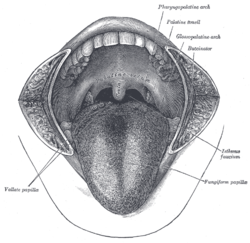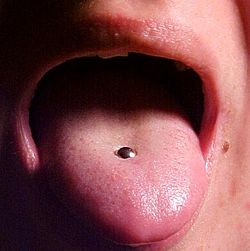This article needs additional citations for verification. (May 2021) |
The lingual septum consists of a vertical layer of fibrous tissue, extending throughout the entire length of the median plane of the tongue, though not quite reaching the dorsum. The lingual septum is closely associated with the hyoglossus membrane, allowing the binding of the tongue to the hyoid muscles.[1]
| Lingual septum | |
|---|---|
 The mouth cavity. The cheeks have been slit transversely and the tongue pulled forward. (Lingual septum is visible at center of tongue, but not labeled.) | |
 A pierced tongue, which has not accommodated for swelling | |
| Details | |
| Identifiers | |
| Latin | septum linguae |
| Anatomical terminology | |
Visualization through implementing a vertical groove along the tongue called the median sulcus.
It is thicker behind than in front, and occasionally contains a small fibrocartilage, about 6 mm. in length.
See also
editReferences
edit- ^ Bordoni, Bruno; Morabito, Bruno; Mitrano, Roberto; Simonelli, Marta; Toccafondi, Anastasia (December 2018). "The Anatomical Relationships of the Tongue with the Body System". Cureus. 10 (12): e3695. doi:10.7759/cureus.3695. PMC 6390887. PMID 30838167.
This article incorporates text in the public domain from page 1132 of the 20th edition of Gray's Anatomy (1918).